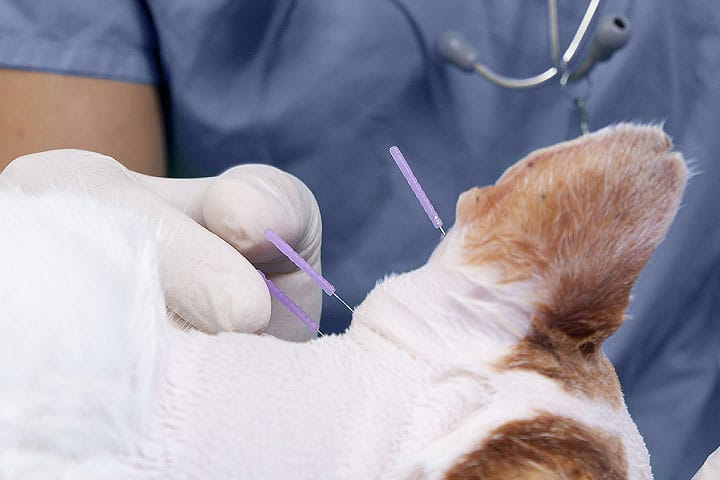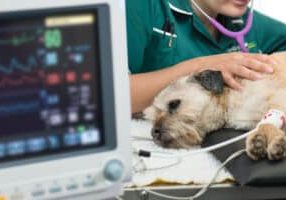
Acupuncture consists of insertion of fine solid needles at certain locations (acupuncture points). The needles are inserted into muscles and left in place for 10 to 20 minutes. Acupuncture finds its origins in traditional Chinese medicine, in which it is believed that needles work by influencing ‘qi’ (energy) that flows through meridians in the body.
Since the 1970s, a group of western trained doctors decided to review this ancient technique in light of present day physiology and applied it alongside western medicine techniques and diagnoses. This gave birth to western medical acupuncture.

Acupuncture competes with nociception. There are five theoretical mechanisms by which acupuncture effects can be explained:
1 Local effects
Release of vasodilatatory mediator calcitonin gene-related peptide (CGRP) with increase in local and deeper tissues’ blood flow, improving healing.
2 Segmental analgesia
Reduction in pain in the segment where the needles are inserted, due to stimulation of A-delta fibres in skin, and A-beta and A-delta fibres in muscles. The signal created by the needle insertion takes priority over chronic pain, with interneurons causing inhibition of transmission of C fibres (slow, dull chronic pain).
3 Extrasegmental analgesia
Stimulation of endogenous analgesic mechanisms at the level of the brainstem. The signal generated from the acupuncture stimulus travels from the dorsal horn. This might explain the whole-body effect and depends on an adequate amount of stimulation.
4 Central regulatory effects
Effects on cerebral cortex, hypothalamus and limbic system.
Influence on autonomic nervous system, nausea, perception of pain (emotional component).
5 Myofascial trigger points
Small painful knots of tight muscles fibres might be inactivated or released by acupuncture.
Animal studies on acupuncture
Some evidence of the effectiveness of acupuncture on pain levels (Still, 1989) and speed/quality of recovery (Hayashi et al., 2007) in dogs with intervertebral disease was found. A cross-over study (9 dogs) showed that electroacupuncture was not effective at improving lameness and pain (measured via visual analog scale) in dogs suffering from elbow osteoarthritis (Kapatkin et al., 2006).
Tatewaki and colleagues (2005) found electroacupuncture at PC6 to be effective at reducing nausea and vomiting and the effects were abolished by naloxone administration. These results were confirmed by a subsequent study of 81 dogs in which acupuncture at PC6 reduced hydromorphone-induced nausea (Scallan and Simon, 2016).
In people, the evidence is so conflicting that different countries have different recommendations regarding the use or not of acupuncture for treatment of osteoarthritis, nausea, migraines.
Potential risks of acupuncture:
- Aggravation of symptoms (usually temporary after treatment)
- Drowsiness, sedation
- Skin infection/cellulitis
- Pneumothorax (only if needled over the chest)
- Bleeding (if coagulopathy)
- Ineffective (20-30% of humans might not find acupuncture effective, and this might be mirrored in our species).
These side effects are fewer than the side effects of commonly prescribed pain medications. In light of these findings and the limited amount of side effects (and the fact that both dogs and cats tolerate it quite well) acupuncture can be part of a multimodal approach to chronic pain in our species.
References and further reading
- Tatewaki, M., Strickland, C., Fukuda, H., Tsuchida, D., Hoshino, E., Pappas, T.N. and Takahashi, T., 2005. Effects of acupuncture on vasopressin-induced emesis in conscious dogs. American Journal of Physiology-Regulatory, Integrative and Comparative Physiology.
- Kapatkin, A.S., Tomasic, M., Beech, J., Meadows, C., Boston, R.C., Mayhew, P.D., Powers, M.Y. and Smith, G.K., 2006. Effects of electrostimulated acupuncture on ground reaction forces and pain scores in dogs with chronic elbow joint arthritis. Journal of the American Veterinary Medical Association, 228(9), pp.1350-1354.
- Still, J., 1989. Analgesic effects of acupuncture in thoracolumbar disc disease in dogs. Journal of Small Animal Practice, 30(5), pp.298-301.
- Scallan, E.M. and Simon, B.T., 2016. The effects of acupuncture point Pericardium 6 on hydromorphone-induced nausea and vomiting in healthy dogs. Veterinary anaesthesia and analgesia, 43(5), pp.495-501.
Case Advice or Arranging a Referral
If you are a veterinary professional and would like to discuss a case with one of our team, or require pre-referral advice about a patient, please call 01883 741449. Alternatively, to refer a case, please use the online referral form
About The Discipline
Anaesthesia

Need case advice or have any questions?
If you have any questions or would like advice on a case please call our dedicated vet line on 01883 741449 and ask to speak to one of our Anaesthesia team.
Advice is freely available, even if the case cannot be referred.
Anaesthesia and Analgesia Team
Our Anaesthesia and Analgesia Team offer a caring, multi-disciplinary approach to all medical and surgical conditions.